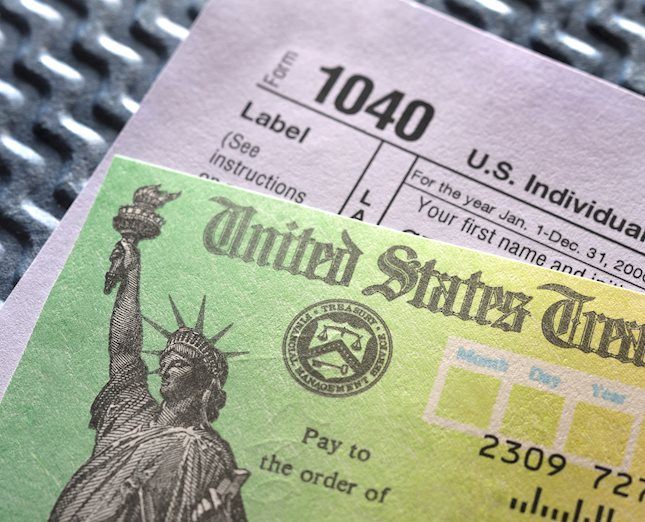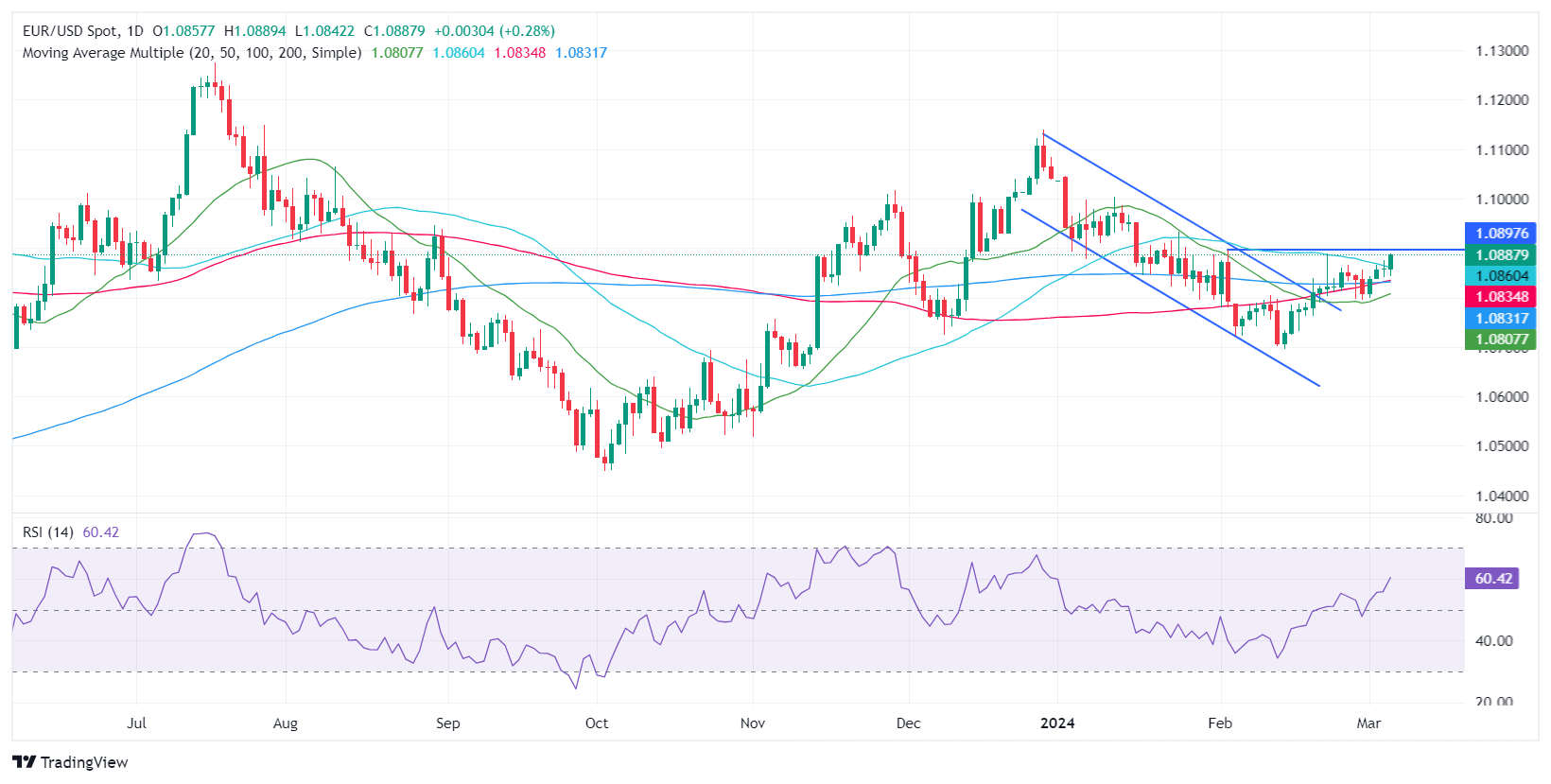- EUR/USD climbs 0.42%, spurred by ADP data and Powell’s remarks.
- US ADP February’s report was solid at 140K, improved compared to January, but missed estimates.
- Fed’s Powell remarks in testimony at Capitol Hill hint at no immediate rate cuts.
The Euro extended its gains against the US Dollar early during the North American session, sponsored by softer-than-expected ADP jobs report in the United States (US). Thus, the EUR/USD edges up 0.42% and trades at 1.0881 after hitting a two-week high of 1.0887.
EUR/USD hits two-week peak, gains momentum ahead of the European Central Bank’s decision
In February, private companies hired fewer people than the 150K expected, with figures increasing by 140K. Nevertheless, compared to January’s 111K reading, the jobs market remains strong, as noted by Nela Richardson, chief economist of ADP. Richardson said “Job gains remain solid. Pay gains are trending lower but are still above inflation.”
Nevertheless, the data was overshadowed by prepared remarks that the US Federal Reserve (Fed) Chairman Jerome Powell will deliver at Capitol Hill. He said the Fed doesn’t expect it will be appropriate to reduce rates until they [Fed] have greater confidence in inflation moving sustainably towards 2%.
Powell said rates had peaked, acknowledged the progress on inflation, and added that the current restrictive stance puts downward pressure on economic activity and inflation. He said they would ease policy at some point in the year, though they would assess incoming data. He added that the risks to achieving the Fed’s dual goal are moving into better balance.
Following the data and Fed’s Powell remarks, the EUR/USD rose sharply. The US Dollar Index (DXY), which tracks the performance of six other currencies against the buck, tumbled more than 0.30% to 103.47. US Treasury bond yields are diving across the short and long ends of the curve.
In addition, traders brace for the European Central Bank's (ECB) monetary policy decision on Thursday, with analysts expecting no change to their monetary policy. However, traders would look for hints, about a possible rate cut towards the June meeting.
EUR/USD Price Analysis: Technical outlook
The pair has broken above a downslope resistance trendline drawn from January’s highs and the 50-day moving average (DMA) at around 1.0860/70, opening the door to challenge 1.0900. Once that level is cleared, the next resistance emerges at 1.0932, the January 24 swing high, followed by the January 11 high at 1.0999, shy of 1.10. On the other hand, if prices fail to stay above the 1.0860 area, look for a deeper pullback towards the confluence of the 100 and 200-DMAs at around 1.0831/34 before testing 1.0800.
Euro FAQs
The Euro is the currency for the 20 European Union countries that belong to the Eurozone. It is the second most heavily traded currency in the world behind the US Dollar. In 2022, it accounted for 31% of all foreign exchange transactions, with an average daily turnover of over $2.2 trillion a day. EUR/USD is the most heavily traded currency pair in the world, accounting for an estimated 30% off all transactions, followed by EUR/JPY (4%), EUR/GBP (3%) and EUR/AUD (2%).
The European Central Bank (ECB) in Frankfurt, Germany, is the reserve bank for the Eurozone. The ECB sets interest rates and manages monetary policy. The ECB’s primary mandate is to maintain price stability, which means either controlling inflation or stimulating growth. Its primary tool is the raising or lowering of interest rates. Relatively high interest rates – or the expectation of higher rates – will usually benefit the Euro and vice versa. The ECB Governing Council makes monetary policy decisions at meetings held eight times a year. Decisions are made by heads of the Eurozone national banks and six permanent members, including the President of the ECB, Christine Lagarde.
Eurozone inflation data, measured by the Harmonized Index of Consumer Prices (HICP), is an important econometric for the Euro. If inflation rises more than expected, especially if above the ECB’s 2% target, it obliges the ECB to raise interest rates to bring it back under control. Relatively high interest rates compared to its counterparts will usually benefit the Euro, as it makes the region more attractive as a place for global investors to park their money.
Data releases gauge the health of the economy and can impact on the Euro. Indicators such as GDP, Manufacturing and Services PMIs, employment, and consumer sentiment surveys can all influence the direction of the single currency. A strong economy is good for the Euro. Not only does it attract more foreign investment but it may encourage the ECB to put up interest rates, which will directly strengthen the Euro. Otherwise, if economic data is weak, the Euro is likely to fall. Economic data for the four largest economies in the euro area (Germany, France, Italy and Spain) are especially significant, as they account for 75% of the Eurozone’s economy.
Another significant data release for the Euro is the Trade Balance. This indicator measures the difference between what a country earns from its exports and what it spends on imports over a given period. If a country produces highly sought after exports then its currency will gain in value purely from the extra demand created from foreign buyers seeking to purchase these goods. Therefore, a positive net Trade Balance strengthens a currency and vice versa for a negative balance.
Information on these pages contains forward-looking statements that involve risks and uncertainties. Markets and instruments profiled on this page are for informational purposes only and should not in any way come across as a recommendation to buy or sell in these assets. You should do your own thorough research before making any investment decisions. FXStreet does not in any way guarantee that this information is free from mistakes, errors, or material misstatements. It also does not guarantee that this information is of a timely nature. Investing in Open Markets involves a great deal of risk, including the loss of all or a portion of your investment, as well as emotional distress. All risks, losses and costs associated with investing, including total loss of principal, are your responsibility. The views and opinions expressed in this article are those of the authors and do not necessarily reflect the official policy or position of FXStreet nor its advertisers. The author will not be held responsible for information that is found at the end of links posted on this page.
If not otherwise explicitly mentioned in the body of the article, at the time of writing, the author has no position in any stock mentioned in this article and no business relationship with any company mentioned. The author has not received compensation for writing this article, other than from FXStreet.
FXStreet and the author do not provide personalized recommendations. The author makes no representations as to the accuracy, completeness, or suitability of this information. FXStreet and the author will not be liable for any errors, omissions or any losses, injuries or damages arising from this information and its display or use. Errors and omissions excepted.
The author and FXStreet are not registered investment advisors and nothing in this article is intended to be investment advice.
Recommended content
Editors’ Picks

EUR/USD drops below 1.0500 after US PMI data
EUR/USD stays under bearish pressure and trades below 1.0500 on Monday. The upbeat ISM Manufacturing PMI data for November provides an additional boost to the US Dollar, forcing the pair to extend its slide in the American session.

GBP/USD slumps below 1.2650 on broad USD strength
Following a consolidation phase in the early European session, GBP/USD turns south and trades below 1.2650 on Monday. The pickup in the safe-haven demand for the US Dollar, in addition to the better-than-forecast US Manufacturing PMI data, weighs on the pair.

Gold hovers around $2,640 without directional strength
Gold starts the new week on the back foot and trades below $2,650. The renewed US Dollar strength and the recovery seen in the US Treasury bond yields don't allow the pair to stage a rebound despite the risk-averse market atmosphere.

The week ahead: Payrolls take centre stage, as French government poised to collapse
At the start of this week, the focus is likely to be on France. On Sunday, Marine Le Pen said that her party’s talks with the government led by Michel Barnier, had broken down, which paves the way for a no-confidence vote in the technocratic government that has no majority in Parliament.

Trump warns BRICS over Dollar rival plans
Donald Trump, the incoming U.S. President, has issued a strong warning to BRICS nations over their plans to challenge the dominance of the U.S. dollar in global trade.

Best Forex Brokers with Low Spreads
VERIFIED Low spreads are crucial for reducing trading costs. Explore top Forex brokers offering competitive spreads and high leverage. Compare options for EUR/USD, GBP/USD, USD/JPY, and Gold.
